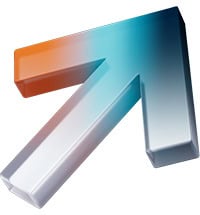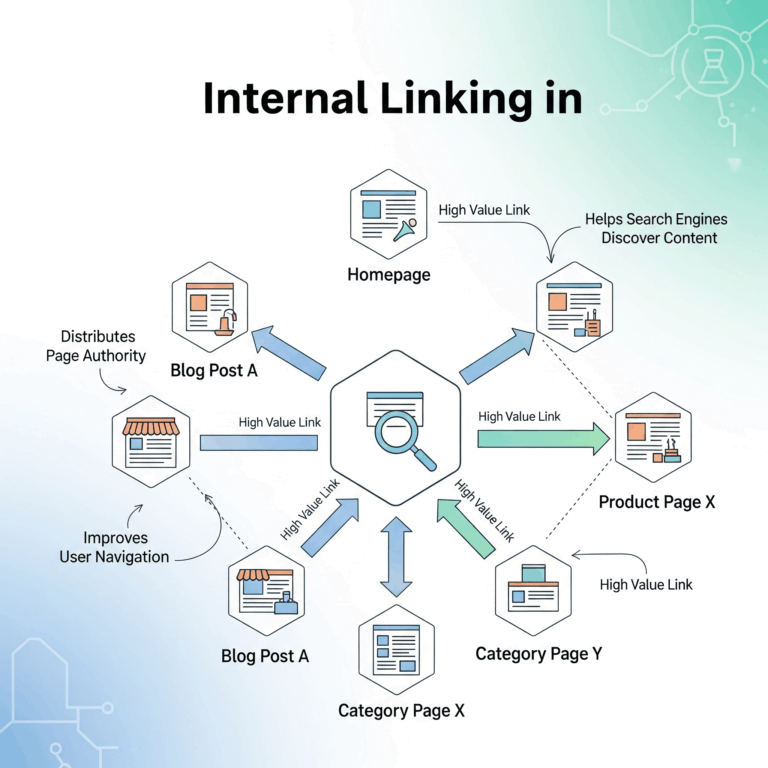Internal linking is one of the key levers for improving your organic search performance. The basic principle is to direct link equity (or popularity) toward strategic pages to strengthen their authority. You often face a dilemma: prioritizing useful outbound links for users or strategic ones for search engines. Link obfuscation allows you to satisfy both Google and your users, without having to choose between usability and SEO performance.
What is link obfuscation?
Search Search engine crawlers follow links on a page:
- Internal links point to other pages on your website.
- External links lead to pages on third-party websites.
Crawling is the first key step in your SEO process.
Obfuscation consists in modifying the appearance of a hyperlink:
- So it remains clickable for users;
- But is not detectable as a link and is not followed by search engines.
The role of links and SEO popularity
Internal links are essential for SEO. We distinguish two main types.
Internal linking
This refers to all the links between pages on your site:
- Main menu (usually on every page),
- Category-specific menus (shown only on certain sections),
- Related items (similar products or articles),
- Contextual links (within body content),
- Footer links, etc.
Internal linking plays a crucial role in structuring your SEO and distributing link equity.
Netlinking
Netlinking, or acquiring backlinks from external sites, has long been a core SEO strategy. These backlinks boost your credibility and visibility in search engine results. When you add external links to your pages, you’re participating in the netlinking of other websites.
The concept of PageRank
PageRank is an algorithm developed by Google to evaluate the importance of a web page. Every link is seen as a vote of confidence. Other search engines use similar systems. PageRank flows from page to page, often referred to as link juice.
Each internal or external link divides and passes on PageRank. The more links you have, the more diluted the authority:
- A page with 10 outbound links gives 10% of its value to each,
- With 100 links, that’s 1% per link,
- With 1,000 links, only 0.1% per link.
This is a simplified example—algorithms also weigh links based on factors like placement (in menus, in content, beginning or end of a page, etc.). Still, the takeaway is clear: too many outbound links dilute your link equity and weaken your strategic pages.
How link obfuscation serves your SEO
Link obfuscation is an advanced SEO technique that helps improve your visibility in search engines. Here are specific use cases where it provides real benefits:
Obfuscation vs rel=”nofollow”
By default, a link passes PageRank (known as a “dofollow” link). However, you can add attributes to the HTML link tag:
- rel=”nofollow”:tells search engines not to follow or pass link equity,
- rel=”sponsored”: for paid or sponsored links,
- rel=”ugc”: for user-generated content (e.g. forums, comments).
The Fasterize link is a nofollow link and will not transmit any popularity to the https://www.fasterize.com/fr/ page.
What happens with nofollow links?
If the popularity is not transmitted with a nofollowlink , it is definitely lost. Compare your web page to a leaky bucket that is constantly filling up and transmitting this water to other buckets via pipes in real time:
- With a dofollow link : water flows through a pipe to another bucket.
- With a nofollow link : the pipe leaks and water spills.;
- With an obfuscated link : the pipe is sealed, no water is lost.
Let’s take the example of a page containing 100 outgoing links:
- With 50 nofollow links: the other dofollow links each receive 1% of the popularity;
- With 50 obfuscated links: the other dofollow links each receive 2% of the popularity.
Link obfuscation is an effective solution for avoiding loss of popularity.
Link to non-indexable page
Use obfuscation instead of nofollow to concentrate crawl budget on indexable pages. For example, footer links to legal notices or terms and conditions can be obfuscated—they’re useful for users but unnecessary for bots.
You can also obfuscate filter/sort links on e-commerce listing pages. These URLs are typically non-indexable for SEO reasons, so there’s no point wasting crawl budget.
Obfuscate external links
External links (e.g., to social media) might appear on every page. While useful to users, they don’t benefit SEO.
Instead of removing them, obfuscate Facebook, Instagram, TikTok, LinkedIn, or YouTube links—preserving user experience and reducing link equity loss.
Obfuscation is also useful for license-based links, such as required citations for images, infographics, or videos.
Segmenting a mega-menu
Mega-menus aren’t ideal for SEO, but they enhance user navigation. Obfuscation lets you silo content for SEO while maintaining a good UX.
Example: On a page in “Universe 2”, only links related to Universe 2 are visible to crawlers. The user still sees the full menu.
| Links visible to the user : Universe 1
| Links visible to search engines: Universe 1 Universe 2
|
This advanced obfuscation creates focused SEO silos.
EdgeSEO for managing link obfuscation
Link obfuscation is usually implemented via JavaScript. But deploying it requires technical skills—and search engines evolve. What’s hidden today may be visible tomorrow.
EdgeSEO offers a powerful, accessible solution:
🔧 No technical knowledge required.
⚙️ Just set your obfuscation rules, and we handle the rest.
✅ Save time.
✅ Stay focused on your SEO strategy.













